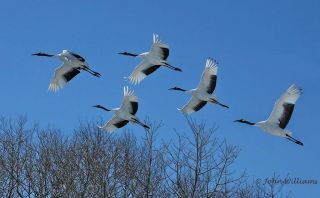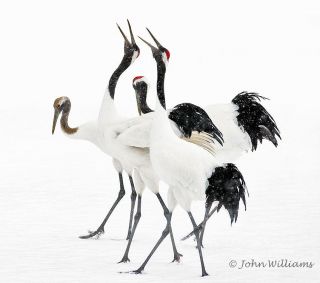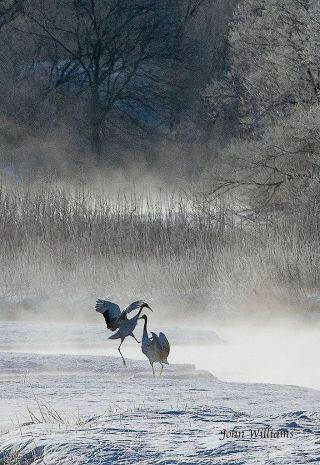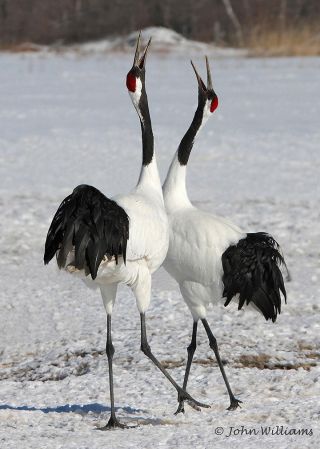Crane flight at dawn © John Williams
Red-crowned Crane Sarurun Kamuy: Our Home Grown Winter Spectacle, an Abundant Future and the End of the “Battle”.
By Mark Brazil | Jan 31, 2017
Renowned as the bird of long life and happiness, and believed to live for a thousand years (in folklore at least), the Red-crowned Crane is a study in exquisite beauty. To encounter this avian dancer is to create a lasting memory as they exude agility, charm and grace. How can one fail to smile on sighting such a living god – Sarurun Kamuy?
Japan’s gatherings of cranes, are justifiably world famous, drawing watchers and photographers from far and wide. But for all that cranes are revered here in Japan, and depicted so widely in advertising on everything from aircraft to saké bottles and wedding kimono, where are the festivals to celebrate them and their role in Japan’s ancient and modern culture, in Japan’s history of conservation and in their significant economic contribution to Japan’s nature-focussed tourism?
Japanese festivals are so impressive that no fewer than thirty-three of them have been proposed by UNESCO as worthy of listing as cultural heritage, yet Japan doesn’t have an internationally renowned crane festival. In fact it doesn’t have a crane festival – period – though the Ainu have dances that honour the role of this bird as their Sarurun Kamuy, the God of the Marshes.
Any day with cranes anywhere in the world is a red-letter day, but winter brings out the best in the landscape of Hokkaido and in Japan’s Red-crowned Cranes making a winter sighting so very special and, I’d argue, one of the greatest wildlife spectacles in the world.
A surefooted Red Fox lopes across the landscape leaving behind a thin dotted line of neat tracks in the snow crust as it crosses the snow-blanketed fields. It turns, enters the riverine woods, flounders briefly in softer snow then emerges higher on the river bank. Below, the fox’s fantasy quarry has already become alert to its presence. The cranes have un-tucked their heads from between their wings, raised their bills as they watch intently. They are poised and ready, but move only a few leisurely paces deeper into the river, then relax. No fox can disturb them here, though they keep a cautious eye in its direction as it glances at them. Does it really consider them possible prey? Foxes are renowned for guile, but a bird of the size of a crane is surely beyond even their cunning. Meanwhile the stately cranes fall back to resting again.
If cranes are prone to worrying then they have more to think about than a wishful fox. After all, these are wetland birds and in Asia wetlands are shrinking fast and breeding sites for wetland birds are becoming ever more crowded. The cranes need secure sites for breeding in summer, and in winter they are dependent on safe foraging grounds and safe roosting sites. Places where they can spend the night standing and sleeping, secure in knowing that ice-free, flowing water, keeps them safe from all manner of predators and human disturbance.
One such site, along a stretch of river near the village of Tsurui in East Hokkaido, has become world famous. A bridge overlooks the site making it possible to admire the cranes at rest. I recall the bridge before the blacktop came. Then the river was quiet, peaceful and occasionally one might meet another crane spectator there, equally enthralled by the silence, the beauty and the birds. Role the clock forward several decades and not only have the numbers of cranes at the roost swollen as conservation efforts have paid off, but the numbers of crane tourists, photographers and birdwatchers has also ballooned. While the increase in the number of cranes is an undoubted success, the question now is how best to manage the arrival of so many people.
The danger of photographers gathering alongside this country road was deemed sufficient to warrant building a dedicated bridge parallel to first, making this the only bridge that I know of in the world that was built specifically for avian-focussed tourism. As visitor numbers increased, arriving early to claim the “perfect” spot became important for photographers. Once, I arrived before daybreak with a television film crew looking to find a suitable spot ahead of the arrival of others, only to find that a photographic group had arrived the night before and lashed their tripods to the railings to occupy “their” space. Thick frost coated their equipment, which, just for a moment I must admit, I was tempted to cut free and dump in the river below.
Mostly the gathering morning crowd is orderly, but what was once a small purely polite and deferential Japanese gathering is now an international one attended by amateur and professional photographers from across Asia, Europe and North America. I have seen modest Japanese photographers crowded out of their prior occupancy by brash and overtopping foreign counterparts, and with the arrival of certain nationalities the volume of the vocal hubbub on the bridge has risen dramatically. Not so the hubbub along the river.
The cranes remain seemingly oblivious to the gathering crowds at dawn. They hunker against heavy frost; they stand impassively as cold dark protective water surges past their legs. As the morning light level begins to rise the first birds wake. Some commence languid foraging along the streamside looking for frogs and fish, some leave the denser gathering and pairs begin to posture, some even breaking into their stirring sky-pointing duets. Occasionally a crane pair launches into a full-on courtship display bugling their excitement across the landscape; almost instantly the waiting cameras on the bridge respond with a staccato rattle as thousands more images are taken.
The scene is timeless and supremely beautiful and despite the noisy crowds at dawn there is yet calm stillness at the heart of this experience. But when the temperature dips low, at its best below -16°C, the scene can only be described as breathtakingly magical. At such temperatures smoke-like crane rises in clouds from the warmer river water into the frigid air. Thick frost gathers on everything, coating twigs branches and the snow over and over until long hoar crystals turn the scene into one from a Swiss chocolate box.
On these super cold mornings, when the sky is clear, frost even forms in the air. Minute crystals of ice catch the light as they tumble through the air. They can barely be seen except in ones peripheral vision against a darker background, but glance sideways and you may just glimpse the famous diamond dust as it glints and reflects the morning sunlight. It looks like magical fairy dust. Turn your back to the rising sun and face upriver and you may see the sun glinting off larger frost crystals in the sunlight appearing to scatter diamonds through the canopy of the riparian woodland.
The crane flock is slower to wake on colder mornings, earlier on milder days, but wake they will and eventually they will leave their roost site. Cranes require a brief run of a few steps in order to unfurl their wings and reach take-off speed so they tend to fly away down the river or come straight up the river towards the bridge. They may peel off to either side, disappearing over the trees and away across the farmland heading for their feeding grounds in Tsurui, but every now and then they continue straight upriver rising slowly so that they pass just over the bridge. Then their leisurely wing beats are just audible above the clattering shutters of uncountable DSLRs. They come as pairs, as families, and occasionally in larger distracting groups leaving photographers distraught – which one should they target. Then the moment has passed and the cranes have gone.
Now it is possible to see more cranes in a short morning excursion in Tsurui than existed in the whole of Hokkaido in the early 1980s. I recall the excitement with Hayashida Tsuneo, the doyen of Japanese crane photographers, of finding a flock of 67 adults and 7 juveniles on a winter’s day in 1982 and thinking what a fantastic number that was for a bird that had faced down extinction just sixty years earlier.
Today the healthy Hokkaido Red-crowned Crane population stands at over 1,500 individuals and seems set for a future of abundance. By touring the main winter feeding grounds in the villages of Akan and Tsurui one can easily find a third or more of them in a day. At the Ito Sanctuary in Tsurui, a Mongolian Oak tree stands centre stage and its late lingering leaves have been the subject of attention for many a young crane over the years. Fallen leaves, deep orange against blue-white snow, skitter in the breeze, exciting youngsters to play “catch-and-throw”. Tossing leaves and twigs skyward and chasing them upwards in leaping aerial steps are a young crane’s way of displaying exuberance and play, a precursor to the steps and motions that will later find their way into more serious courtship displays.
A prancing youngster makes for a lively distraction amongst the Red-crowned Crane flock at this site. The field slopes and rises to the south offering a suitable site on which the birds alight and from which they like to depart. There is much action here and in late afternoons it is possible to find infectious juvenile prancing beneath the oak spreading to mature dancing as the whole flock (youngsters, families and courting couples alike) engages in collective dancing.
The dance at Akan Tancho no Sato, a little further to the west, is of a very different kind. There, the provision of an afternoon feed of live fish has for several decades (until December 2016) made this the most popular site with casual and dedicated crane watchers alike. Its proximity to Kushiro’s Tancho Airport helps.
In recent years a flock of Whooper Swans has found this venue too. These great yellow-white birds appear lumpen as they sit passively in the snow, barely moving, only reaching out around them with their long necks to deftly pick up corn kernels without rising. At times, small herds of Japanese Deer have also put in an appearance, always willing to snaffle a free meal, and Red Fox linger at the field edge await their opportunity too.
A dozen or more White-tailed Eagles would gather in the final minutes before the world-renowned two-o’clock feed, each looking for its chance to swoop in, dodging the lunging beaks of the cranes, to snatch a fish. Hordes of photographers have gathered here for the perfect shot of crane and eagle together; their goal to capture an image of “the battle”, the briefest of moments when both eagle and crane are airborne, the eagle intent on capturing a fish and the crane intent on attacking the eagle.
Such battles have been thrilling and dramatic to watch, and have driven photographers to endure long days in the cold and snow to capture a mere second or two of exciting action, but perhaps, with the cessation of the afternoon feeding, these stirring battles will soon be just a fading memory, as nowhere else do cranes and eagles interact so closely in Japan. Meanwhile, a fox would slink towards the margin of the flock, biding its time, watching, before making a dash, running the gauntlet of crane bills and eagle talons. I saw a fox once, with a fish clamped successfully in its jaw, so attentive to the jabbing cranes that it missed the action above it and took a terrible thump on its back from a frustrated eagle – the fox dropped the fish which was then snatched in turn by an opportunistic Black-eared Kite. That was true natural drama indeed.
In recent years, the drama has been of the human kind as coach loads of touring visitors each with their smart phone cameras, and vanloads of dedicated photographers armed with massive tripods and monstrous telephoto lenses, have jostled (not always amicably) for space. As the moment of the feeding neared they were standing in ranks three and four deep at the rail each attempting to obtain a better view. On one occasion there were more than 400 visitors all aiming their attention at fewer than 200 cranes.
As the numbers of cranes in Hokkaido increased until they surpassed 1,000, and now that they have even exceeded 1,500, the concern is less about helping to raise their numbers and more about preventing them from succumbing to diseases that might spread through larger flocks at few gatherings. With that in mind the winter feeding programmes are slowly being scaled back, a process that will no doubt lead to changes in the behaviour of the birds.
Increasingly pairs and families have been forsaking the crowded feeding sites and are wintering around farmyards, where they forage on the invertebrates surviving in warm manure piles, or they wander freely along the streams that now remain ice-free during winter. This process will perhaps accelerate now as food at the few main provisioned sites will likely be insufficient in future to go around all the birds tempted to gather there. This changing behaviour now makes it possible to “bump-into” cranes over a much wider range of East Hokkaido during the winter months. I became a naturalist to avoid interactions with people and to escape gatherings and crowds, but now I find that so many “natural” sites are themselves crowded. It is time to move on! Finding for oneself a family of cranes away from the major flocks (and away from the tourist crowds) is now a guilty pleasure.
A rattling drumming emanates from high in a riverside tree. The tree’s trunk is caked with snow its branches dusted white and forming a delicate tracery in silhouette against a deep blue sky. Though it is still early in the year and the land still firmly in the grip of winter this natural clattering sound (not that of cameras!) signals that, for the local woodpeckers, the coming breeding season is beginning to drive their behaviour once again. It does so too for Hokkaido’s largest resident bird, the Red-crowned Crane.
As the winter proceeds and the days lengthen the crane pairs become amorous once more and on occasions a new call can be heard from the flock. A steady soft “kuru-kuru-kuru…” is a signal indicating that a pair is engaged in more than just courtship. Moments after calling the male mounts his mate and having achieved their brief cloacal kiss, amongst much wing waving, they separate, but not before they engage in a beautiful display of their long-term bondedness. Through their dramatic displays and courtship these birds maintain their pair bonds through the winter and in a few weeks time, as the ice and snow finally commence thawing, the cranes will leave their gathering grounds and disperse, returning once more to their remote territory where they will breed once more. But that is a different story.
The majority of this month's photographs have been kindly contributed by John Williams. Thanks John!
If you would like to showcase your images in this column please contact enquiries@japannatureguides.com
Outro
If you have read this far, then you may enjoy my previous articles, including recent offerings such as: Searching for the Grey Ghost: Kamoshika (December 2016); Dancing With The Birds of Happiness (November 2016); Duck anyone? Mallard or Muscovite? (October 2016); Damsels and Dragons: Aerial Dancers (September 2016); Halcyon Days (August 2016); Isolated in the Izu Islands (July 2016); Japan’s Ubiquitous Scavenger – The Black-eared Kite (June 2016); Oriental Stork Making a Comeback in Japan (May 2016); Daijugarami: Stepping Stone to the Arctic (April 2016); Whale Watching Japan-style: Zamami (March 2016), Snow Monkeys & Cranes of Japan: Spectacular Winter Wildlife (February 2016), and Amami Night Safari (January 2016).
These Wild Watch articles, and many more, can be found on this website, and on our Facebook page (please do visit and hit the “Like” button).
Author, naturalist, lecturer and expedition leader, Dr Mark Brazil has written his Wild Watch column continuously since April 1982, first in The Japan Times for 33 years, and since 2015 here on this website. All Wild Watch articles dating back to 1999 are archived here for your reading pleasure.
A collection of Mark’s essays The Nature of Japan and two handy pocket guides The Common and Iconic Birds of Japan and The Common and Iconic Mammals of Japan have been published and are also available from www.japannatureguides.com
























